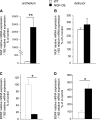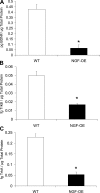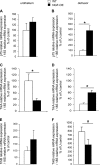Neurotrophin/receptor expression in urinary bladder of mice with overexpression of NGF in urothelium
- PMID: 21048026
- PMCID: PMC3043996
- DOI: 10.1152/ajprenal.00515.2010
Neurotrophin/receptor expression in urinary bladder of mice with overexpression of NGF in urothelium
Abstract
Urothelium-specific overexpression of nerve growth factor (NGF) in the urinary bladder of transgenic mice stimulates neuronal sprouting in the urinary bladder, produces increased voiding frequency, and results in increased referred somatic hypersensitivity. Additional NGF-mediated pleiotropic changes might contribute to the increased voiding frequency and pelvic hypersensitivity observed in these transgenic mice, such as modulation of other growth factor/receptor systems. Chronic overexpression of NGF in the urothelium was achieved through the use of a highly urothelium-specific uroplakin II promoter. In the present study, we examined NGF, brain-derived neurotrophic factor (BDNF), and associated receptor [p75(NTR), tyrosine kinase (Trk)A, TrkB] transcript and protein expression in urothelium and detrusor smooth muscle of NGF-overexpressing (OE) and littermate wild-type mice, using real-time quantitative reverse transcription-polymerase chain reaction, ELISAs, and semiquantitation of immunohistochemistry. We focused on these growth factor/receptors given the established roles of NGF/TrkA, NGF/p75(NTR), and BDNF/TrkB systems in bladder function. Increased voiding frequency in NGF-OE mice was confirmed by examining urination patterns. BDNF, TrkA, and TrkB protein expression was significantly (P ≤ 0.01) reduced and p75(NTR) protein expression was significantly (P ≤ 0.01) increased in urinary bladder of NGF-OE mice. The NGF-OE-induced changes in neurotrophic factor/receptor expression in urinary bladder may represent compensatory changes to reduce voiding frequency in the NGF-OE mouse.
Figures







References
-
- Abramoff MD, Magelhaes PJ, Ram SJ. Image processing with ImageJ. Biophotonics Int 11: 36–42, 2004
-
- Allen SJ, Dawbarn D. Clinical relevance of the neurotrophins and their receptors. Clin Sci (Lond) 110: 175–191, 2006 - PubMed
-
- Aloe L. The effect of nerve growth factor and its antibody on mast cells in vivo. J Neuroimmunol 18: 1–12, 1988 - PubMed
-
- Baskin L, DiSandro M, Li Y, Li W, Hayward S, Cunha G. Mesenchymal-epithelial interactions in bladder smooth muscle development: effects of the local tissue environment. J Urol 165: 1283–1288, 2001 - PubMed
Publication types
MeSH terms
Substances
Grants and funding
LinkOut - more resources
Full Text Sources
Other Literature Sources
Molecular Biology Databases
Research Materials

